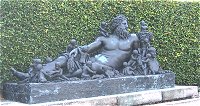Nile RiverMuseum Label: |
Chiurazzi description:
Famous group of Alessandrine art that symbolizes the allegory of the River Nile. The 16
putti which so exquisitely surround the body of the old peaceful man represent the 16
cubits (1 cubit was some 20 inches) of water that rises during the rainy season .
Original size: 310 cm. Origin: Museo Vaticano
Subject info:
The original black marble sculpture was first recorded in 1523, when it was
installed as a fountain in the middle of the Belvedere sculpture court, facing the Tiber
sculpture. Both sculptures were ceded to France in 1797, but unlike the Tiber it was
returned after Waterloo and installed in the Vatican Museum.
The putti in the sculpture existed only as broken fragments until added in 1774.An early theory was that there had originally been 17 putti, representing the 17 kingdoms in Egypt, watered by the Nile. The correct interpretation was that the 16 putti clambering over the god referred to the 16 cubits by which the river could rise in the rainy season. The Belvedere sculpture is catalogued by Helbig as a sculpture copied under the Roman Empire from a Hellenistic statue probably of Alexandrian origin, perhaps with some elaboration.
Another entry from the old docent files:
The bearded river god is shown wearing leaves and holding a sheaf of wheat and horn of
plenty. He is surrounded by small boys, each representing one of the sixteen cubits the
Nile rose in flood stage. A crocodile is an allegory for the river and the pyramid is
Egypt. It was displayed with The River Tiber, but it was praised as being more skillfully
executed than its companion piece.
The Vatican Nile, itself a copy of a Hellenistic statue, probably Alexandrian in origin,
was discovered in the early sixteenth century in excavations of the shrine to Isis and
Serapis near Santa Maria sopra Minerva in Rome. Pliny the Elder mentions a similar
sculpture in ancient Egypt in his Natural History (36.58), explaining that the babies
surrounding the river god represent the ideal height of sixteen cubits to which the Nile
river rose annually, thereby assuring abundant fertility in Lower Egypt. The Nile's
waters, carved as wavy lines and embellished with ibisis, crocodiles, and hippopotami on
the Vatican group, are more effectively replaced with wet drapery on the Volpato version
due to its smaller size. The Neoclassical flavor of such drapery prefigures its later use
by sculptors such as Canova.
